11 Types of Most Common Butterflies in Vermont (With Pictures)
-
Jana Blagojevic
- Last updated:
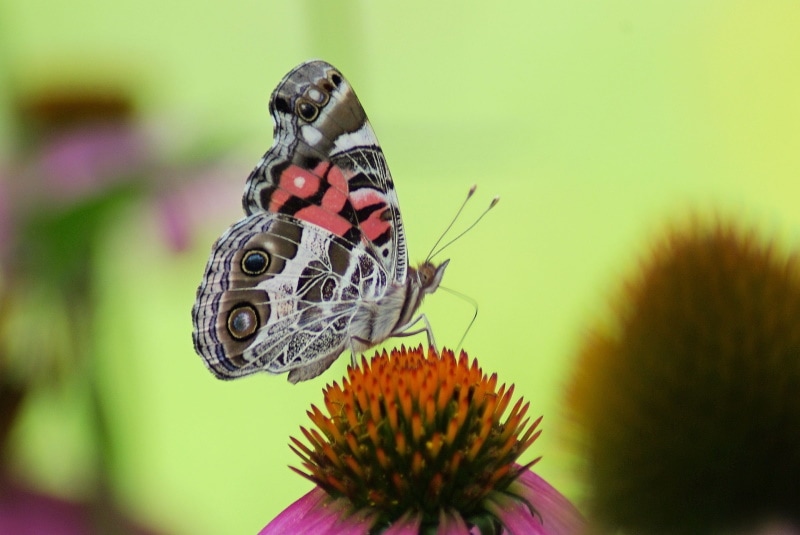
Vermont offers a home and sanctuary to hundreds of butterfly species. Each species is unique, with colorful patterns that put on a stunning show when seen in person. If you live in Vermont, you probably noticed some of these lovely butterfly species in your backyard, and now you are wondering what species they might be.
If you want to be able to recognize the most common butterfly species in Vermont, read the article below, where some of the most unique and gorgeous species are listed.
The 11 Types of Most Common Butterflies in Vermont
1. American Lady
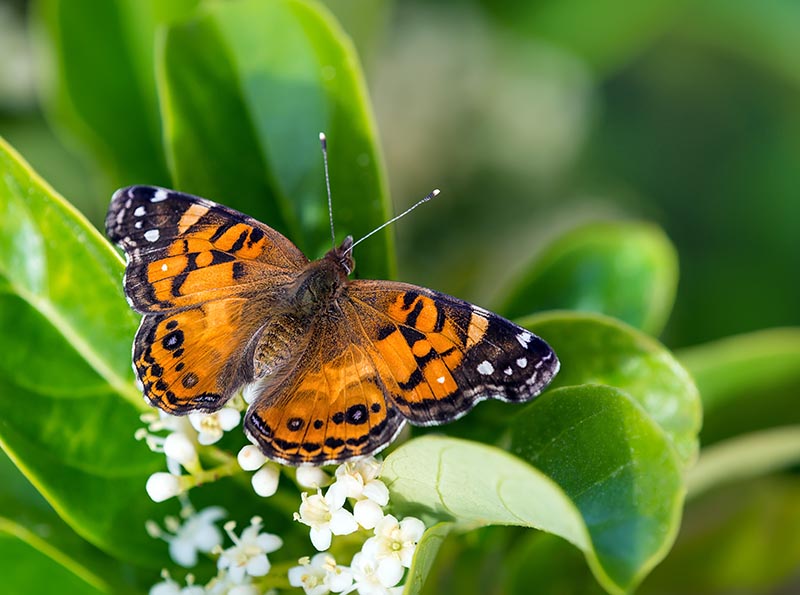
| Scientific name | Vanessa virginiensis |
| Range | Southern Canada throughout the United States |
| Habitat | Wet meadows, large forests |
The American Lady is an orange and black butterfly with distinctive white spots on its wings. The front legs of this butterfly are covered with short hairs or bristles. Cobweb patterns on the underside characterize the wings of the American Lady. This butterfly prefers sunny locations such as meadows, large forests, or open fields.
2. Mourning Cloak
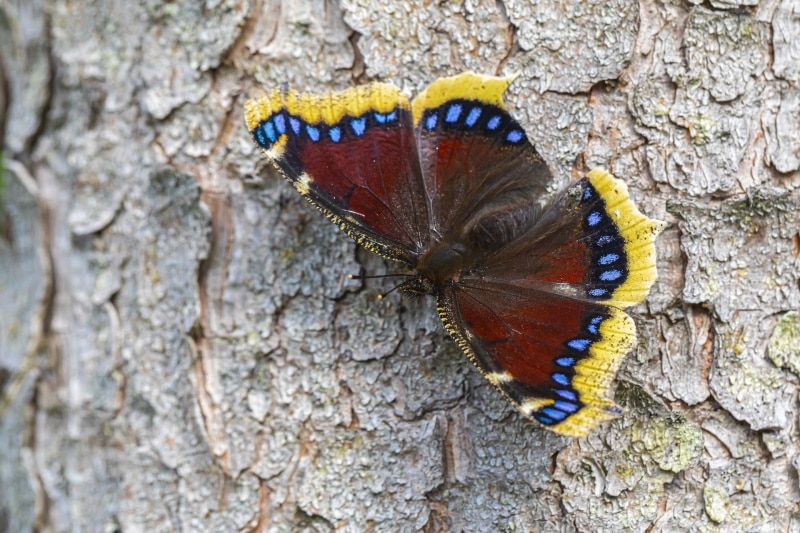
| Scientific name | Nymphalis antiopa |
| Range | From Canada to southern South America |
| Habitat | Parks, gardens, lakes, streams, ponds |
The Mourning Cloak is famous for its maroon wing color, with blueish spots closer to the edge and intense yellow margins. The Mourning Cloak feeds primarily on tree sap but also on rotting fruit. Like most butterfly pieces, they also enjoy early blooming shrubs and nectar. You can find the Mourning Cloak in forests, parks, and fields.
3. Gray Hairstreak
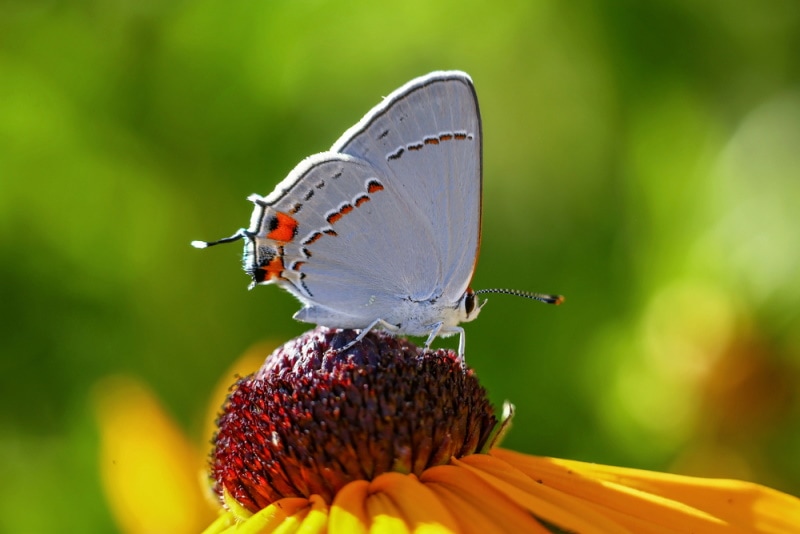
| Scientific name | Strymon melinus |
| Range | Southern Canada to Central and northern South America |
| Habitat | Woodland areas, forests, meadows, parks |
As the name suggests, the Gray Hairstreak is a primarily gray butterfly with lovely patterns. Each wing has a black and white stripe, with orange-capped black spots above the tails. Females are usually larger than males, with blueish tints on the gray wings. Unlike most butterfly species, these butterflies don’t stay in only one habitat, instead are widespread across forests, meadows, and woodlands.
4. Red-Spotted Purple
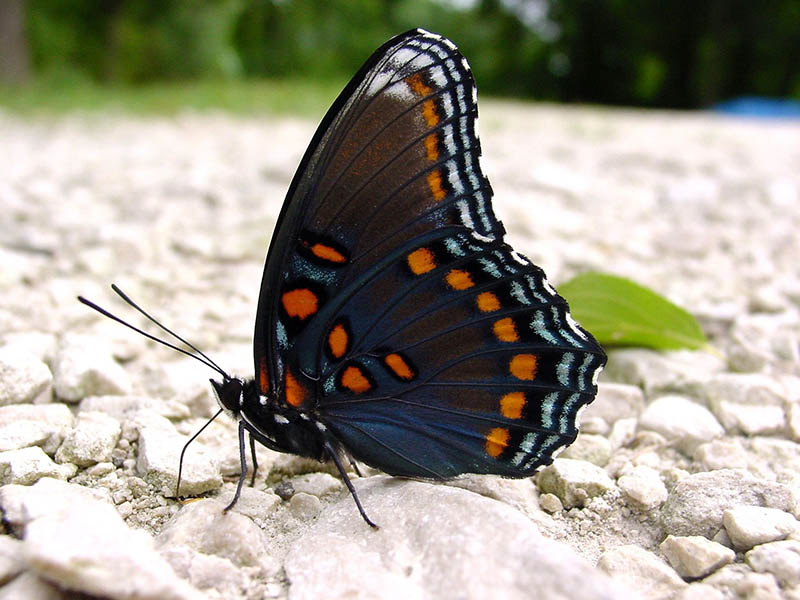
| Scientific name | Limenitis arthemis astyanax |
| Range | Eastern United States |
| Habitat | Streams and woodlands |
The Red-Spotted Purple is black, with stunning blue shading towards the wings’ borders. The hindwings have three orange spots near the base, and the forewings have two red bars. This butterfly is a lovely forest species commonly found in wooded areas.
5. Red Admiral
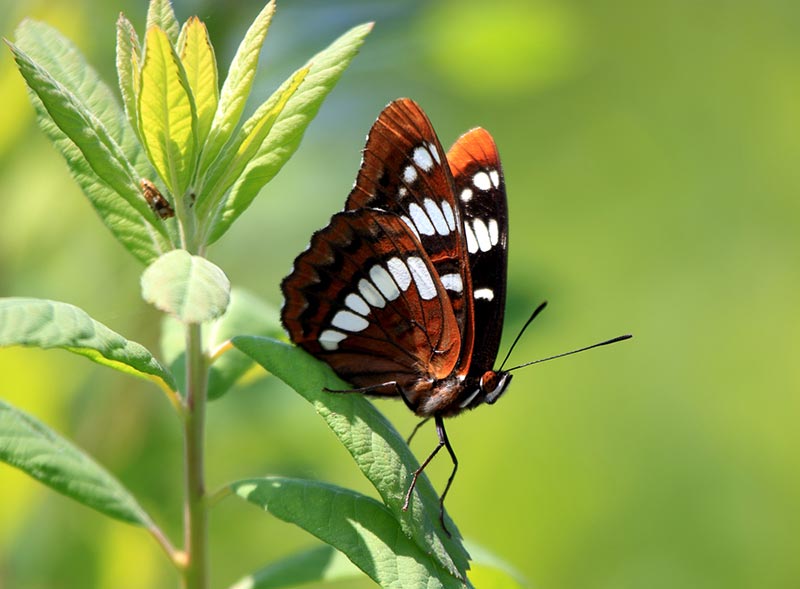
| Scientific name | Vanessa atalanta |
| Range | Europe, Asia, North Africa, the United States, and the Caribbean |
| Habitat | Seasides, mountains, and residential gardens |
The Red Admiral is a large and stunning butterfly you can often spot in residential gardens. This butterfly is medium-sized, with characteristic black wings. Across the wings, vivid red stripes are visible, with white spots on the borders. The Red Admiral resides in warmer climates, typically moist woodlands, seasides, and mountains.
6. White Admiral
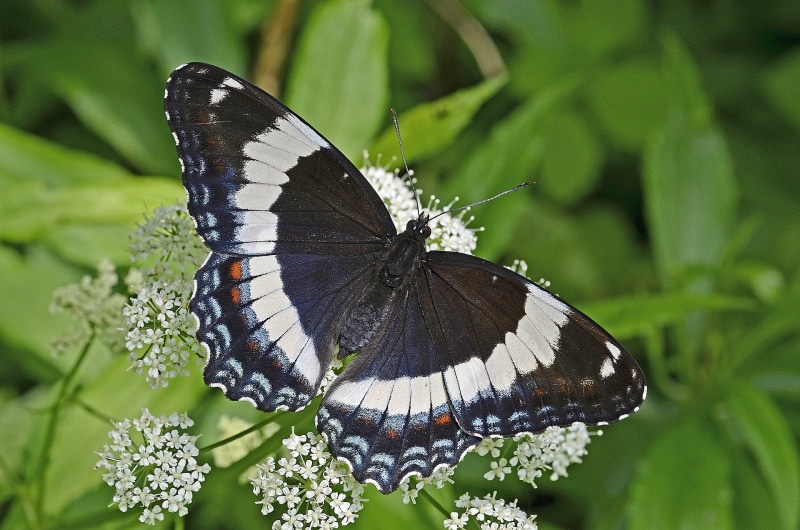
| Scientific name | Limenitis arthemis |
| Range | North America, Eurasia, Japan |
| Habitat | Shady woodlands, roadsides, forests |
White Admirals are gorgeous medium-sized butterflies with dark, black wings. Except for red stripes, this butterfly is almost identical to the Red Admiral. The White Admiral has lovely white dotted lines across the wings. The distinctive flight makes this butterfly easily recognizable in the garden; they make several short wing beats followed by long glides.
7. Common Wood-Nymph
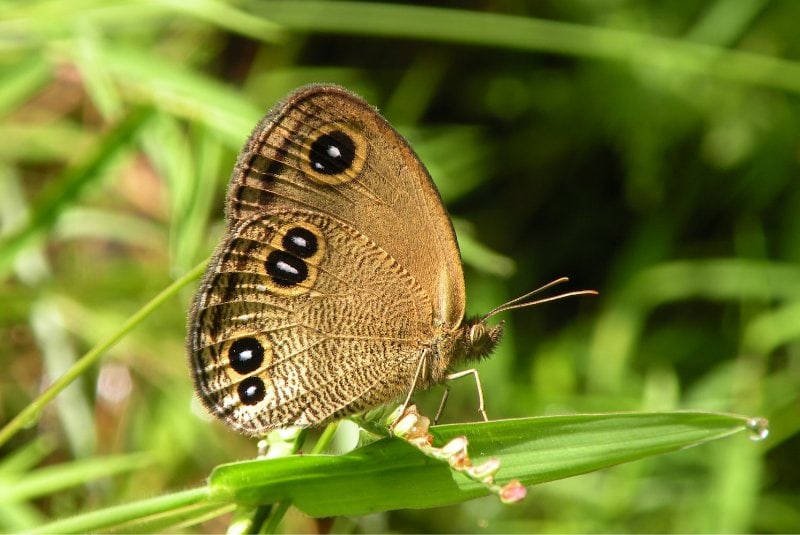
| Scientific name | Cercyonis pegala |
| Range | Southern Canada, continental United States |
| Habitat | Woodlands, meadows, prairies, wetlands |
The Common Wood-Nymph is a genuinely unique butterfly species, also known as the “Google Eye” or simply “Wood-nymph.” The wings are brown, with two pairs of distinctive eye spots on each wing. These butterflies are often seen in woodlands, fields, wet meadows, and pastures. Each Wood-Nymph butterfly’s appearance varies slightly, but each can be easily recognized in the wilderness.
8. Pearl Crescent

| Scientific name | Phyciodes tharos |
| Range | North America |
| Habitat | Pastures, fields, pine woods |
The Pearl Crescent butterfly is a very colorful and intense species with an orange surface on the wings covered by fine black markings or veins. The borders of the wings are shaded black, with tiny white marks lined up. The name “Pearl Crescent” comes from the pearly white marks on the underside of the hindwing.
9. Aphrodite Fritillary
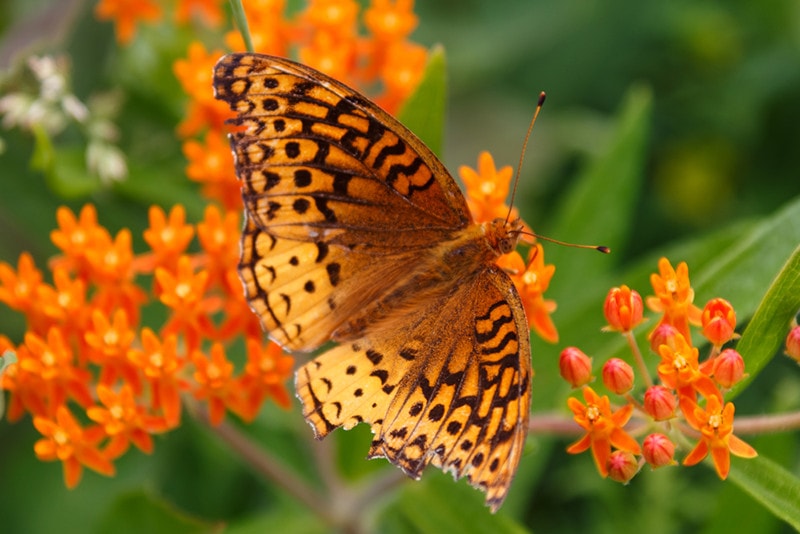
| Scientific name | Speyeria aphrodite |
| Range | North America |
| Habitat | Woods, wet meadows, prairies |
The Aphrodite Fritillary is a butterfly with a lovely orange surface, with black spots covering the entire upper side of the wings. The underside has multiple white dots inside thin black circles. These butterflies can usually be spotted in prairies and wet meadows, feeding on nectar from plants such as milkweed and viper’s bugloss.
10. Spicebush Swallowtail
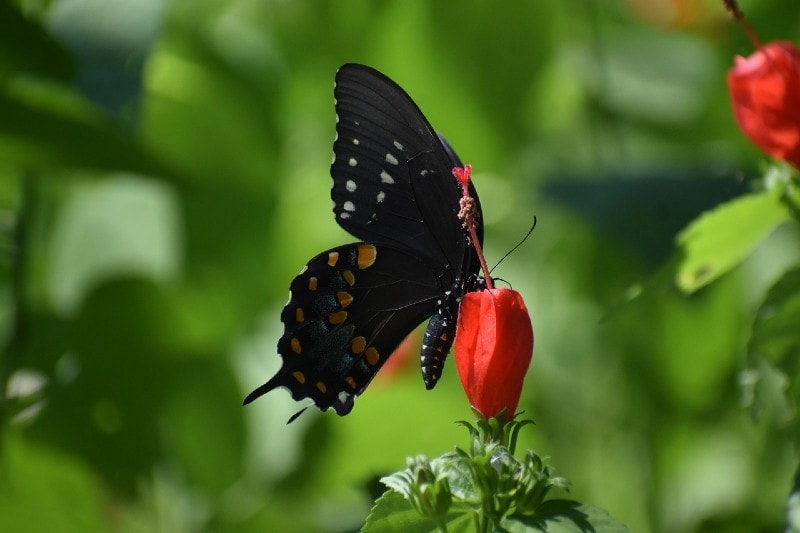
| Scientific name | Papilio troilus |
| Range | Eastern United States |
| Habitat | Wooded areas |
The Spicebush Swallowtail is a large butterfly with a stunning dark appearance. Its wings are dark black with lovely blueish shading towards the ends. On the wing’s margins are rows of white dots, followed by two long tails on the ends. They tend to move in wooded areas such as forests, parks, and roadsides, feeding on nectar from milkweed, thistles, and jewelweed.
11. Cabbage White
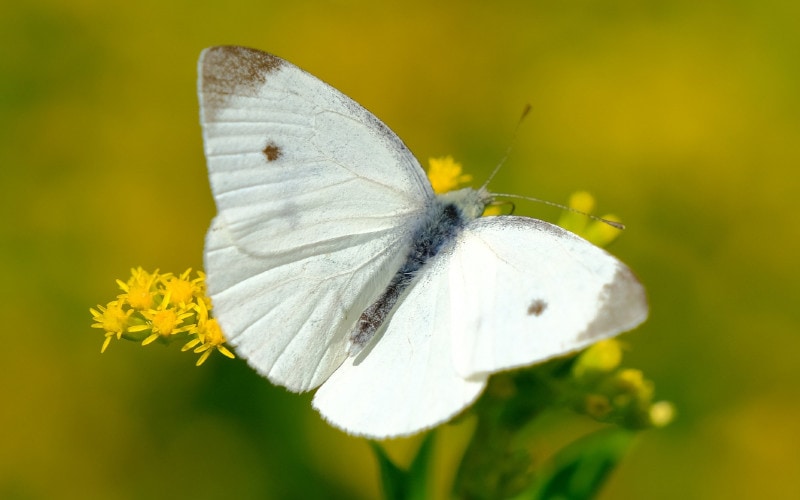
| Scientific name | Pieris rapae |
| Range | Central Canada throughout the United States |
| Habitat | Meadows, woods, bogs, suburbs, and residential gardens |
The Cabbage White is a small to medium-sized butterfly known for its delicate and gentle appearance. The wings are colored creamy white, with distinctive brownish dots on the back of the wings. On the very tips of the forewings, there are small, recognizable black bands.
Conclusion
Many butterfly species can be spotted in Vermont and the most popular ones you can see are listed in the article above. If you want to earn a new skill—recognizing these butterflies in your garden—read the descriptions carefully as they contain the basic information about the butterfly’s unique appearances.
Featured Image Credit: Mike Goad, Shutterstock
Contents
